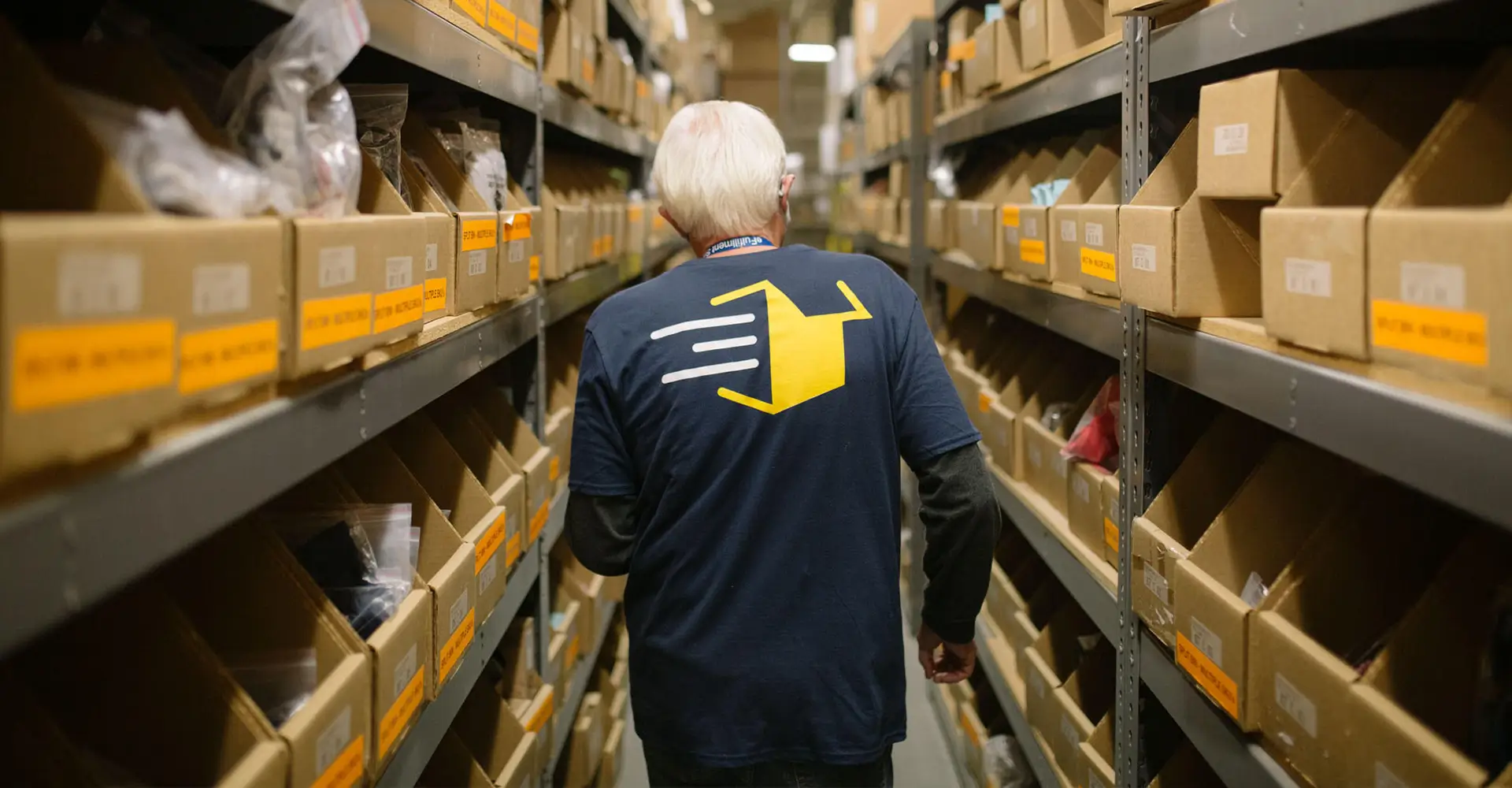
Picture this: you’re at the helm of a bustling ecommerce apparel store. It’s the peak of the shopping season, and your latest fashion line has just launched. Customers are flocking to your website, orders are pouring in, and your team is buzzing with activity. But then, amidst this whirlwind of success, you hit a snag – your best-selling item suddenly shows as ‘out of stock’. Panic sets in as you realize that due to an inventory error, you’ve been selling a product you don’t have. This scenario, a retailer’s nightmare, is precisely why mastering apparel inventory management is not just important, but essential.
This comprehensive guide is designed to walk you through the best practices, innovative strategies, and expert tips in apparel inventory management. Whether you’re grappling with warehousing challenges, demand forecasting, or supply chain complexities, this article will provide you with insightful, professional, and actionable advice to revolutionize your approach.
Jump right in: Fulfillment Status: What Does it Mean?
- Section 1: Understanding the Basics of Apparel Inventory Management
- Section 2: Warehousing Strategies for Apparel Ecommerce
- Section 3: Mastering Demand Forecasting
- Section 4: Supply Chain Management Essentials
- Section 5: The Power of 3PL in Apparel Inventory Management
- Section 6: Key Performance Indicators (KPIs) to Track
- Section 7: Common Pitfalls in Apparel Inventory Management and How to Avoid Them
- Summary and Key Take-Aways
Section 1: Understanding the Basics of Apparel Inventory Management

The Fundamentals Defined
At its core, inventory management in apparel ecommerce is the strategic orchestration of acquiring, storing, and selling inventory. This process is pivotal, as it ensures that the right products are available at the right time, and in the right quantities – a critical factor in customer satisfaction and business sustainability.
In the apparel industry, inventory management takes on additional layers of complexity. Fashion trends are transient, seasonality impacts demand, and consumer preferences can shift rapidly. For ecommerce businesses, especially small to medium-sized ones, this means constantly adapting strategies to align with these evolving dynamics.
Key Components of Effective Inventory Management

Warehousing:
This is the physical hub where your inventory lives. But it’s more than just storage. Effective warehousing involves the strategic organization of goods for easy access and efficient distribution. It’s about maximizing space utilization, maintaining inventory accuracy, and ensuring the safety and quality of the stored apparel. In ecommerce, warehousing also involves understanding how to handle returns efficiently, a common challenge in the apparel sector.

Demand Forecasting:
This component is akin to looking into a crystal ball, but with data instead of magic. Demand forecasting in apparel ecommerce involves analyzing past sales data, market trends, and even social media trends to predict what your customers will want in the future. Getting this right means avoiding overstocking (which ties up capital) and understocking (which leads to lost sales).
Supply Chain Management:
This is the backbone of inventory management. Supply chain management in apparel involves coordinating with manufacturers, suppliers, transporters, and warehouses to ensure that inventory moves smoothly from production to sale. It’s a complex dance that requires agility and precision, especially when dealing with global suppliers and the uncertainties of international shipping.
The Evolving Landscape in the U.S. Market

The U.S. apparel ecommerce market is witnessing significant changes. Technological advancements, like AI and machine learning, are reshaping how inventory is managed. These tools are helping predict trends more accurately, optimize warehouse layouts, and even automate restocking.
Moreover, the rise of sustainable and ethical fashion is influencing inventory decisions. Consumers are increasingly aware of and interested in how their clothes are made and distributed, leading to a shift in how businesses manage their inventory to align with these values.
In this dynamic environment, small to medium-sized ecommerce businesses must be nimble and well-informed. Understanding and implementing the fundamentals of inventory management is not just a necessity but a strategic step towards thriving in the ever-changing landscape of U.S. apparel retail.
Section 2: Warehousing Strategies for Apparel Ecommerce

Implementing Best Practices in Warehousing
Warehousing, in the context of apparel ecommerce, is far more than just storing products. It’s about creating an environment where inventory is managed efficiently, safely, and in a way that aligns with dynamic business needs.
- Organized Layout and Categorization: For apparel businesses, an organized warehouse layout is crucial. Grouping items based on categories, seasons, or even color can save time and reduce errors during order fulfillment. This categorization also aids in faster stock audits and replenishment.
- Climate Control and Security: Apparel items often have specific storage requirements. Materials like leather or silk may need climate-controlled environments to prevent damage. Additionally, security measures to protect high-value items are essential, as losses due to theft or damage can significantly impact profitability.
- Efficient Space Utilization: Utilizing vertical space with appropriate shelving systems and considering compact storage solutions can significantly increase warehouse capacity. This is particularly important for small to medium-sized businesses that may not have extensive warehouse space.

Adopting Efficient Storage Solutions
Efficient storage solutions are about maximizing space and accessibility while minimizing errors and handling time.
- Automated Storage and Retrieval Systems (AS/RS): These systems can enhance storage density and reduce the time spent on retrieving items. They are particularly beneficial for businesses with a large variety of stock keeping units (SKUs).
- Mobile Shelving Units: For smaller businesses, mobile shelving units offer flexibility. They can be reconfigured based on current stock levels and seasonal changes, making them a versatile option for apparel warehousing.
- Barcode and RFID Systems: Implementing barcode or RFID tagging for inventory items streamlines tracking and reduces the chances of misplacing items within the warehouse.

Leveraging Technology in Modern Warehousing
The role of technology in warehousing has become increasingly significant, offering tools to enhance efficiency and accuracy.
- Warehouse Management Systems (WMS): These systems offer a centralized platform to manage all warehousing operations. They can track inventory levels, optimize picking and packing processes, and provide valuable insights into inventory turnover rates.
- Integration with Ecommerce Platforms: Integrating WMS with ecommerce platforms ensures real-time inventory tracking. This integration allows for immediate updates on stock levels, reducing the risk of overselling and helping manage customer expectations more effectively.
- Use of Robotics and AI: Advanced warehouses are now employing robotics for tasks like picking and packing, reducing manual errors and increasing speed. AI algorithms can predict inventory needs, optimize storage layouts, and even automate restocking orders based on historical sales data.
In conclusion, efficient warehousing strategies are a critical component of successful apparel inventory management. They not only streamline operations but also provide a foundation for scalability and responsiveness in the fast-paced world of ecommerce. By adopting these best practices and leveraging modern technology, small to medium-sized apparel businesses can significantly enhance their operational efficiency and customer satisfaction.
Section 3: Mastering Demand Forecasting

The Critical Role of Demand Forecasting in Apparel Ecommerce
Accurate demand forecasting is a cornerstone for success in apparel ecommerce. It’s crucial because it influences every aspect of the business – from inventory levels and storage requirements to marketing strategies and customer satisfaction. In the apparel industry, where trends can quickly come and go, and seasonality plays a significant role, predicting demand accurately becomes both challenging and essential. An effective demand forecast ensures that you have the right products available at the right time, avoiding both overstock and stockouts, which are detrimental to business health and growth.
Techniques and Tools for Effective Forecasting
Historical Sales
Data Analysis
Start with your sales history. Identify patterns, peak seasons, and best-selling items. Tools like time-series analysis can help in understanding how sales have fluctuated over time and predicting future trends.
Market Trend
Analysis
Pay attention to industry trends. This includes fashion trends, consumer spending habits, and changes in the economic environment. Leveraging tools like Google Trends or social media analytics can provide insights into what consumers are currently interested in.
Consumer Behavior
Studies
Understand your customer. Utilizing customer surveys, feedback, and online behavior analysis tools can give you an edge in anticipating their future needs.
Predictive
Analytics
Advanced tools like predictive analytics use algorithms and machine learning to analyze large sets of data and make more accurate predictions about future demand.
Case Study: Apparel E-commerce and the Importance of Demand Forecasting

A case study illustrating the significance of demand forecasting can be seen in the context of an e-commerce business, as detailed in an AWS whitepaper. This business faced the challenge of optimizing decisions in its supply chain, particularly in-stock management, which is critical for maintaining a competitive edge. The key to their strategy was creating accurate demand forecasts, enabling them to make essential downstream supply chain decisions.
This involved several steps, including data collection and aggregation, data preparation, creating predictors, evaluating these predictors, and automating forecast generation. They used a probabilistic forecast approach, which allowed them to consider not just a single likely future but a range of possible outcomes. This approach was particularly beneficial for managing key products where they almost never wanted to be out of stock. By using different quantiles from the probabilistic forecast, they could tailor their inventory strategies to different product types, ensuring optimal stock levels.
This case study demonstrates how an integrated approach to demand forecasting, combining data analytics with strategic planning, can significantly enhance inventory management in an e-commerce setting.
In summary, mastering demand forecasting in apparel ecommerce involves a blend of data-driven analysis, understanding market and consumer trends, and leveraging advanced forecasting tools. By doing so, businesses can optimize their inventory levels, cater to customer demands effectively, and maintain a competitive edge in the fast-paced world of fashion retail.
Section 4: Supply Chain Management Essentials

Navigating the Complexities of Apparel Supply Chains
Supply chain management (SCM) in the apparel industry is a multifaceted and intricate process that extends far beyond the confines of a single business. It encompasses a series of steps including sourcing raw materials, manufacturing, transportation, warehousing, and finally delivering products to consumers. In the context of ecommerce, especially for small to medium-sized businesses, mastering SCM is critical for ensuring product availability, maintaining quality, and optimizing costs.
Strategies for Optimizing the Apparel Supply Chain
- Strategic Sourcing: The first step in an efficient supply chain is identifying and partnering with the right suppliers. This means not only considering cost but also factors like quality, reliability, and ethical practices. Building strong relationships with suppliers can lead to more favorable terms and a more resilient supply chain.
- Lean Inventory Management: Adopting a lean approach to inventory can significantly reduce costs and increase efficiency. This involves maintaining just enough inventory to meet demand, thus minimizing warehousing costs and reducing the risk of obsolete stock.
- Technology Integration: Utilizing modern SCM software can provide real-time data and analytics, facilitating better decision-making. Technologies like RFID (Radio-Frequency Identification) for tracking inventory, and ERP (Enterprise Resource Planning) systems for integrating various supply chain processes are vital for modern apparel businesses.
- Agile Response to Market Changes: The ability to quickly adapt to market trends is crucial in the apparel industry. This agility can be achieved through practices like just-in-time manufacturing, dropshipping, and having flexible logistics solutions.
- Sustainability Practices: Implementing eco-friendly practices in the supply chain is not just good for the planet, but it’s also becoming a business imperative. Consumers are increasingly favoring brands that demonstrate environmental responsibility.
The Impact of Global Trends on Local Supply Chains
The globalization of the apparel industry has led to supply chains that span across multiple countries, making them susceptible to global trends and events. For instance, trade policies, international tariffs, and global economic conditions can all have a significant impact on costs and efficiency.
Additionally, the recent push towards digital transformation in the global market is influencing local supply chains. The rise of ecommerce platforms and online marketplaces is necessitating faster and more efficient logistics solutions.
Moreover, global events like the COVID-19 pandemic have highlighted the need for supply chain resilience. Disruptions in one part of the world can lead to significant impacts downstream, causing delays and shortages. This situation has underscored the importance of having diversified supply sources and a robust risk management strategy.
In conclusion, effective supply chain management in the apparel industry requires a blend of strategic planning, technological integration, and adaptability to both local and global trends. For small to medium-sized ecommerce businesses, excelling in SCM can be the key differentiator that sets them apart in the competitive apparel market.
Section 5: The Power of a 3PL in Apparel Inventory Management
In ecommerce, Third-Party Logistics (3PL) services are not just a convenience, they’re a catalyst for transformation. The integration of 3PL into your inventory management strategy can elevate your business, allowing you to focus on growth while logistics experts handle the complexities of inventory management.

Understanding 3PL Services
3PL providers are specialized companies that take over various aspects of your supply chain, particularly inventory management, warehousing, and order fulfillment. This delegation of logistics functions is particularly beneficial for small to medium-sized apparel businesses that may not have the resources to manage large-scale logistics operations internally.
Key Benefits of 3PL for Inventory Management
Expertise and Experience: 3PL providers bring a wealth of knowledge in logistics management. This expertise is invaluable in navigating the nuances of apparel inventory, which can be fraught with challenges like seasonal fluctuations and trend-driven demand.
- Cost Savings: By leveraging the infrastructure and economies of scale of a 3PL provider, your business can significantly reduce overhead costs associated with warehousing and shipping.
- Scalability: As your business grows, a 3PL can easily adjust to handle increased inventory and order volumes, ensuring that your growth isn’t hampered by logistical limitations.
- Enhanced Customer Experience: With 3PLs managing efficient order fulfillment, your business can offer faster shipping times and accurate order processing, thereby improving customer satisfaction.

Integration with Ecommerce Platforms
One of the most significant advantages of modern 3PL services is their ability to seamlessly integrate with major ecommerce platforms like Shopify, Amazon, and WooCommerce. This integration allows for real-time inventory tracking, automated order fulfillment, and streamlined returns management. It essentially bridges the gap between your online store and the physical logistics of your inventory.
For instance, when a customer places an order on your Shopify store, the 3PL service automatically receives the order details, picks the item from the warehouse, and prepares it for shipment. This process minimizes errors and speeds up delivery times, enhancing the overall customer experience.
Are You Ready for a Fulfillment Service?
Are fulfillment services the key to scaling your business efficiently? Use this simple quiz to find out! Score each of the following eight questions from 1 to 5 (where 1 = Strongly Disagree, 5 = Strongly Agree) to evaluate if a fulfillment service might be a good choice for your company.
Section 6: Key Performance Indicators (KPIs) to Track

In the intricate dance of inventory management, every step counts. This is where Key Performance Indicators (KPIs) play their pivotal role, acting as the compass guiding businesses through the complex seas of apparel inventory management. For small to medium-sized ecommerce businesses, understanding and tracking the right KPIs can mean the difference between thriving and merely surviving.
Key KPIs in Apparel Inventory Management
Minimize Inventory Error Rate:
- What It Measures: The accuracy of your inventory records. A high error rate indicates discrepancies between physical stock and inventory records.
- How to Improve: Implement regular audits, leverage inventory management software, and train staff on accurate stock handling.
- Measurement: Calculate by dividing the number of inventory errors by the total inventory entries over a specific period.
Stockout and Backorder Reduction:
- What It Measures: The frequency of instances when items are out of stock or backordered.
- How to Improve: Enhance demand forecasting, maintain safety stock levels, and develop efficient reorder processes.
- Measurement: Monitor the number of stockouts and backorders over time and aim for a downward trend.
Optimization of Slow-Moving Inventory:
- What It Measures: The proportion of inventory that moves at a slower rate than expected.
- How to Improve: Implement clearance strategies, adjust purchasing practices, and analyze customer buying patterns.
- Measurement: Identify items with low turnover rates and calculate the percentage of total inventory they represent.
Efficiency in Order Processing:
- What It Measures: The speed and accuracy with which orders are processed and fulfilled.
- How to Improve: Streamline order processing workflows, automate where possible, and train staff for efficiency.
- Measurement: Track the average time from order placement to shipment and the error rate in order fulfillment.
Fulfill Orders Effortlessly!
Measuring and Improving These KPIs
To effectively measure these KPIs, businesses need to embrace technology. Inventory management software that integrates with your ecommerce platform and 3PL services can provide real-time data and analytics, making KPI tracking a seamless part of your business process.
Improvement starts with data. Regularly review your KPIs to identify trends, areas of improvement, and the impact of any changes you implement. Engage in continuous learning and stay updated with industry best practices. Remember, inventory management is dynamic; what worked yesterday might not be sufficient tomorrow.
In conclusion, KPIs in apparel inventory management are much more than mere metrics. They are the guiding stars that lead to a well-oiled inventory system, ensuring that your business is always a step ahead in meeting its goals. By meticulously tracking and improving these KPIs, you can transform your inventory management into a robust, responsive, and reliable system, perfectly aligned with the needs of your ecommerce business.
Section 7: Common Pitfalls in Apparel Inventory Management and How to Avoid Them
Navigating the complexities of apparel inventory management is akin to a strategic game, where each move counts. Even the most diligent ecommerce businesses can encounter pitfalls. Let’s dissect these common missteps and, more importantly, how to steer clear of them.

Pitfall 1: Inaccurate Demand Forecasting
One of the most prevalent challenges is the miscalculation of market demand. It’s a tightrope walk between overstocking, leading to dead stock, and understocking, resulting in missed sales opportunities.
Solution: Embrace data-driven forecasting tools. Leverage historical sales data, market trends, and predictive analytics. Remember, effective forecasting is an ongoing process, not a one-time event.

Pitfall 2: Neglecting Stock Rotation
Apparel trends are fleeting. Yesterday’s fashion can quickly become today’s passé, leaving you with obsolete stock.
Solution: Implement a First-In, First-Out (FIFO) system. Regularly review your inventory to identify slow-moving items and consider promotional strategies to move them.

Pitfall 3: Underestimating the Returns Process
In the world of online apparel retail, returns are inevitable. A cumbersome returns process can lead to stock mismanagement and customer dissatisfaction.
Solution: Develop a streamlined returns system or get the assistance of a 3PL to help simplify your returns process. This includes clear return policies, efficient restocking procedures, and responsive customer service.

Pitfall 4: Poor Integration with 3PL and Ecommerce Platforms
Failing to fully integrate your inventory management system with 3PL services and ecommerce platforms can lead to a disjointed operation.
Solution: Ensure seamless integration. This means real-time data synchronization, automated order processing, and consistent communication channels between all systems.

Pitfall 5: Overlooking Inventory Accuracy
Inventory discrepancies can wreak havoc on your business, leading to unfulfilled orders and lost revenue.
Solution: Regular audits and consistent inventory checks are crucial. Utilize RFID technology or barcode scanning for real-time inventory tracking.
Summary – Choosing a Fulfillment Service: eCommerce Sellers Guide
In this comprehensive article, we delved into the intricate world of Apparel Inventory Management, offering industry expert insights and tips. The article is divided into several sections, each addressing crucial aspects of this complex subject.
Key Takeaways:
- Understanding Basics: Apparel inventory management is about acquiring, storing, and selling inventory strategically, especially crucial due to fashion trends and seasonal impacts.
- Components of Management: Effective inventory management includes warehousing, demand forecasting, and supply chain coordination.
- U.S. Market Dynamics: Technological advancements and the rise of sustainable fashion are shaping the U.S. apparel market, necessitating adaptability and informed decisions.
- Warehousing Strategies: Organized layouts, climate control, and space utilization are vital in apparel warehousing, while automation and technology play pivotal roles.
- Demand Forecasting: Accurate forecasting involves historical data analysis, market trends, and predictive analytics.
- Supply Chain Management: Strategies like strategic sourcing, lean inventory, technology integration, and agility are essential in navigating supply chain complexities.
- 3PL Services: Third-Party Logistics providers offer expertise, cost savings, scalability, and seamless integration with ecommerce platforms.
- KPI Tracking: Key Performance Indicators are essential for monitoring inventory accuracy, stockouts, slow-moving inventory, and order processing efficiency.
- Common Pitfalls: Pitfalls like inaccurate forecasting, neglecting stock rotation, returns mismanagement, integration issues, and inventory inaccuracies can be avoided with strategic solutions.
This article aims to equip small to medium-sized ecommerce businesses with the knowledge and tools needed to excel in the competitive world of apparel ecommerce.
Your Next Steps
Ready to embark on a journey toward streamlined logistics and enhanced growth? Reach out to eFulfillment Service for a bespoke fulfillment solution. We specialize in helping business like yours navigate the complexities of order fulfillment with ease and efficiency. Here’s what we offer:
- A Free Quote: CONTACT US TODAY to get a free quote and learn how our services can be customized to your unique business needs.
- Proven Track Record: Our commitment to excellence is reflected in the TESTIMONIALS FROM NUMEROUS SATISFIED CLIENTS.
- Tailored Solutions: We understand that each startup has its unique challenges, and we’re here to offer solutions that fit perfectly with your business model.
Let eFulfillment Service be your partner in transforming your fulfillment process, enhancing your customer experience, and catapulting your business to new heights.




0 Comments